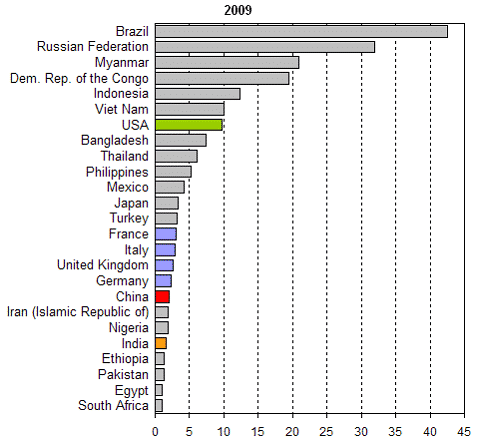Thoughts on Commodity Prices and China’s Hydropower Push
Andy Lees of UBS’s London-based Equity Derivatives group had an interesting post this morning on the push in China to maintain sufficient energy resources in order to maintain economic growth. He writes:
Yesterday China gave the go-ahead to the power generation company Huadian to build a cascade of 13 dams on the Nu river, overturning a suspension ordered by the premier since 2004. The dams combined will have a capacity of 21.3GW, similar to the Three Gorges. Last month the NDRC said China will build an additional 140GW of hydro power capacity over the next 5 years as well as 80GW of pump storage as it tries to achieve its goal of producing 15% of its energy from non-fossil fuel source by 2020, with hydro power accounting for 9% of the total energy mix.
In the latest 5 year plan the China Electricity Council says that the development of hydro electric power has now become a priority, and that large and medium sized projects will all be granted approval. In July last year the Jinsha River hydropower project was granted approval, and Lu Di La and Long Kaikou were also granted permission. Because of environmental concerns only 1/3rd of the 70GW of projects set out in the 11th 5 year plan were completed, but they will now be resumed. In the Nujiang Lisu Autonomous region there are 88 new projects currently under construction adding to the 44 already completed. The NDRC has approved 30 hydropower projects since 2010. These are on small and medium sized rivers. China has also announced it will spend CNY4trn (USD608bn) over the next 10 years in water conservation programmes, saying that both the floods and droughts have exposed the inadequacies of its water infrastructure. I am assuming that some of this spending is double counting as they will undoubtedly view the reservoirs created behind the dams as part of the solution.
What is stunning is that the NDRC says that to meet the 9% power target, of the 400 million kilowatts in available hydropower resources, 380 million need to be developed – (https://www.eeo.com.cn/ens/Industry/2011/01/24/192214.shtml). CITIC Securities also say that with 200GW of capacity presently, 180GW needs to be developed over the next 10 years. Whilst China is talking about using small and medium sized rivers which are clearly going to be far more capital and resource intensive than the large rivers, if they are seriously talking about extracting 95% of the energy from all the rivers (380GW out of a potential 400GW), then the costs will rise exponentially.
If you imagine the power of a fluid moves by the cubic power. If you halve the river speed (height the water falls) the power falls by 7/8ths or 87.5%, so having several power stations on different stretches of the rivers become incredibly inefficient and costly. This may make you think that the figures cannot be correct because of the shear lunacy of what it means, but given that their aim is to get 9% of all their energy from hydro, and given how energy inefficient China is, it does literally appear that China will build systems designed to extract 95% of all the potential hydro power across its river systems. Just to reinforce these numbers, the book Solar Fraud highlights that if 100% of the rainfall of Connecticut (annual average rainfall is 44 inches) was collected behind a 60 meter dam flooding over half the state, then ignoring how long it would take to fill, the round-the-clock power would only produce about 6.5% of the states electricity needs. This example, however, would realise energy far more efficiently than China as it is based on a 60 metre dam and years and years of accumulated rainfall filling that dam which is something that China could not possibly do, so it makes China’s 9% energy figure seem unrealistic unless it is particularly blessed with heavy rainfall, which as you can see below is most certainly not the case (also see where Egypt is, and imagine how that will change if the Nile Basin Cooperative Framework goes through in mid May that will redraw who controls the Nile).
Total Renewable Water Resources Per Capita
This is testament to China’s need for energy infrastructure as well as its need to tap external sources of energy in Africa, central Asia, Africa and Latin America. The Lees piece reminds me of a BBC Documentary podcast on Chongqing I listened to called "China: Shaking the World" and the monumental task of making this inland city connected to the rest of China and the outside world to act as a magnet for the hundreds of millions leaving villages in search of employment in China’s cities. Chongqing is the home to 30 million people and the focal point of the Three Gorges Dam project, another major energy project and the largest dam in world history, requiring the migration of millions.
As awe-inspiring as all of this is, Andy suggests a law of diminishing returns here.
With each successive dam, the capital intensity of energy extraction will rise. The number of dams needed to capture this amount of energy, and the resource intensity of these dams and embankments etc will mean China’s demand for steel and cement is likely to remain extremely elevated over the next few years just from this. When we talk about inefficiencies and costs of these dams, one of the largest costs will be in land. A lot of that will be hillsides used for grazing or fertile valleys used for general agriculture. In the Connecticut example earlier, half of the state’s land would have been lost to water. Whilst this is not going to be the case with China as its dams will not be that big, the reality is that it is already in agricultural land deficit so any further erosion will be extremely important. Given that China gets a high yield per acre out of its land (very low yield per unit of fertilizer) this will have major implications for the world grain balance.
China has temporarily stopped the industrial use of grains, repeating its actions of 2007/08 to meet its food needs, and has instructed the energy industry that they cannot sell energy to industry until they have met fertilizer needs. China already uses 4 times the fertilizer per acre than the world on average, but by removing the natural distribution of nutrients by the rivers, fertilizer use normally has to soar to compensate, often negating a large amount of energy that the dam produces. Whether this can happen with China or not will have to be seen due to the already high use and the poor quality of the fuel.
With a few exceptions, the best dams have already been built and the most powerful waters already controlled, so it seems almost certain that to double the hydro capacity over the next 10 years will need many multiples more land to be lost to the cause with the obvious impact on food supplies. Given China’s rapidly rising energy deficit, which in 2010 was already up to 12% of its total, it is not going to hold back from damming up rivers that leave its borders and are vital to other countries as we saw last year with its admission that it had started building the dams for hydropower plants over the Brahmaputra, India’s second largest river system. This has already started to negatively affect the Mekong and Vietnamese rice yields, and has stopped rivers flowing into Kazakhstan, whilst India is now on the hit list.
The NDRC has warned the provinces a couple of weeks ago that China’s economic growth will be limited by the available supplies of land, water and energy. The Society of Hydroelectric Engineering, talking its own book, says that developing hydro is essential as “the demand for coal is much higher than its production and transport capacity, creating a supply-demand gap. The only way to fill the gap is to encourage development of smaller mines”. We know that wages are set to continue soaring due to an exhausted labour supply since China reached the Lewis Point. None of these are temporary cyclical factors; they are all structural and as such will continue to weigh on China’s trade surplus and its ability to hold Treasuries. Its resource and capital intensity of output will continue to rise. China and the disinflationary force it had on the rest of the world was always a factor mobilisation story, but now those factors of production are exhausting, we should now look on China as inflationary. Its trade surplus will continue its rapid decline and then it will have no choice but to start selling its Treasuries. The only question is how long before its surplus disappears.
The chart below shows China’s terms of trade – (this is just the relative price of commodity exports and imports) – which is collapsing as per 2008. This is unlikely to lead to similar decline in international trade and demand destruction in the short term due to QE, however it will result in rapidly rising export prices and a transfer of accumulated surpluses or FX reserves.
The bottom line here is that China is the largest of the emerging markets now attempting to increase per capita income and grow a dynamic middle class. This will take enormous amounts of natural resources to pull off. In that sense, emerging markets are competing with the developed economies for natural resources. But a burgeoning middle class also consumes more energy and food. The concomitant impact on commodities markets is already being felt. Take this chart from a story today in Forbes on cattle futures.
The commodities story is deeply intertwined with the emerging markets growth story. Here are some questions I have regarding the market impact:
- Nouriel Roubini sees stagflationary implications from civil unrest in the Mideast. How will this wildcard affect cost pressures and will it be a crucial element in destabilising global growth?
- We know that markets in which prices rise invite momentum speculators. In a world of excess liquidity, how much of the move in commodity markets is based on these fundamental supply/demand issues and how much is due to speculation?
- Are these prices ever going to pass through in a large way to developed economy consumers? China is being buffeted by inflation, as are Brazil and India. At some point, this cost increase has to be passed through. The ISM report yesterday showed building cost pressures in the manufacturing pipeline. When will consumers feel it in full measure?
I don’t have the answers to these questions but it bears remembering that oil is a major input across the board in the food and energy complex. And oil price spikes have been associated with every major economic downturn since the end of Bretton Woods forty years ago. It sounds like the Saudis are concerned about the negative implications of $100 oil. But, will they be able to do anything about it?
Sources:
- China: Shaking the World – BBC
- Making Up for Lost Time: China’s Hydropower Push – Economic Observer



If China are targeting hydro energy production as a priority then they are going to fail. Greatly improved energy efficiency will far more cost effective, and could be easier to achieve. It will also create new businesses for exporting that technology. China is doing the right thing in terms of wind-power and these could provide much power especially in remote areas.
If China are targeting hydro energy production as a priority then they are going to fail. Greatly improved energy efficiency will far more cost effective, and could be easier to achieve. It will also create new businesses for exporting that technology. China is doing the right thing in terms of wind-power and these could provide much power especially in remote areas.